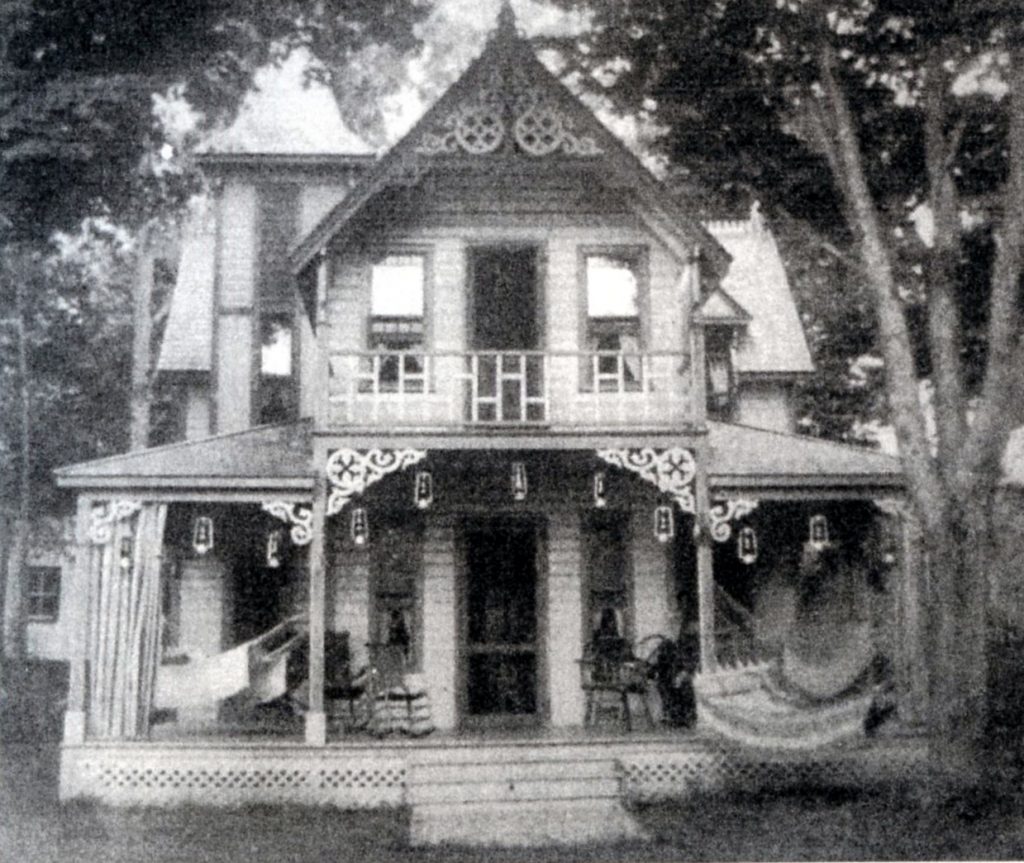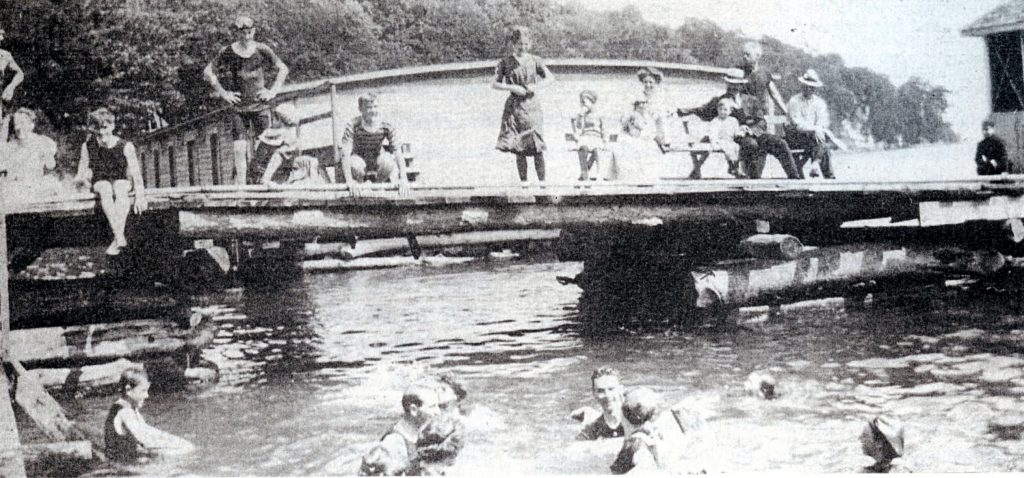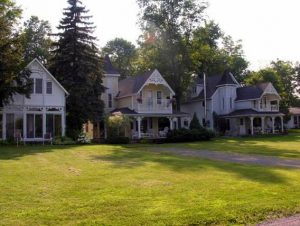Butternut Bay
Butternut Bay is located at the very western edge of Elizabethtown Township in the First Concession along the banks of the St. Lawrence River.

In Thad. W.H. Leavitt’s book “History of Leeds and Grenville” published in 1879 he writes the following about Butternut Bay: (It was originally called “St. Lawrence Central Camp Ground”
“This beautiful and healthful summer resort and Camp Meeting Ground, is situate on a high bluff of the St. Lawrence, in the first Concession of the Township of Elizabethtown. The ground is admirably located, commanding a fine view of the majestic river. Nature has done much to make the spot a coveted summer retreat. The grounds, embracing some twenty-five acres, are finely wooded, being in that respect superior to the Parks located on Well’s Island. To the untiring exertion of the Rev. A.D. Traveller, assisted by other ministers, is fue the honor of having established the first permanent Park upon the Canadian side of the river. In 1875, the land was purchased and is now held and controlled by the Bay of Quinte Conference of the Methodist Episcopal Church. A spacious Tabernacle, a Boarding House and about thirty beautiful Cottages have been erected, and others are in the process of completion. Two sessions of religious services are held each year, one in June and the other in September. Among the contemplated improvements is the establishment of a Telegraph Office, a Post Office and a Custom’s Office. At the close of the season (1878), six series of religious meetings had been held upon the grounds. It certainly is not asking too much of Canadians to expect them to cordially assist the undertaking. The Park is only three and a half miles from Brockville, with which it is in constant communication through the medium of a comfortable steamer, during the sessions of religious service. A special feature of attraction is the establishment of a Sunday School Parliament, which assembles annually during the June Session. The price of lots has been placed very low, to enable all classes to secure a summer home, the intention being to make the Park not only a Camp Ground but also a permanent place of residence during the summer months.”
In Alvyn Austin’s book “Elizabethtown: The Last of the Royal Townships” pub 2009 we learn the following about The St. Lawrence Campground (Butternut Bay).
“Rev. A.D. Traveller, the minister of George Street Methodist Episcopal church in Brockville, bought 25 acres of Jessup’s Tract in 1875, a bluff surrounding a little bay in the river. He planned a religious campground like the famous Chautauga, with lectures and music in addition to the religious sermons. There were several religious campgrounds on the American side, at Morristown and Wellesley Island, larger and more urban than Butternut, as well as further afield like Old Orchard Beach, Maine. There were only in Ontario, the St. Lawrence Campground and Grimsby, which has disappeared.
The Camp meetings promoted a teaching called Holiness, an important evangelical doctrine which permeated Canadian churches into the 20th century. Holiness teachings (also called Entire Sanctification by John Wesley) stated that believers could by conscious diligence live without sin. Moreover they should expect an intense religious experience, a “Second conversion”, in secular terms ‘regeneration’, and thereafter would live the Higher (or Deeper) Life, free from sin. The best place to induce this emotional fervour was a ‘primitive’ woodland setting, ‘a grove of trees to shade the worshippers, log seats, an elevated stand for the preachers, tents, a spring of clean water, burning pine knots for light, and a way of dealing with rowdies and liquor sellers’

At first the people lived in tents, and the meetings were held under a large marquee ‘tabernacle’. The land was surveyed into lots 30 by 40 feet, and leased to church members for $10. for a tent lot and $25. for a cottage lot “and an annual rental of one peppercorn, for a period of 999 years. The building committee set a standard design for the cottages, a small farm house ornamented with a square, mansard-roofed tower and deep overhanging gingerbread, far out of scale with the house. A frame tabernacle, a post office and telegraph, general store and custom’s house were added. One advertisement enticed prospective buyers with “good lodging, abundant and healthful food, beautiful lots for those who wish to pitch tents or erect cottages, wide streets, broad parks and a fresh water ocean, well stocked with fish, boats, good society, and the very noblest of intellectual and religious entertainment.”
The following are excerpts from a booklet published in 2006 “Butternut Bay a Treasured Summer community” by Dr. Reginald Anderson and Bob Anderson:
The ‘Cliff Chateau Hotel’
The original hotel was built in 1885 and was destroyed in the windstorm of 1888. It was rebuilt in 1889 by Mr. M.B.Slack of Lyn and was known as the Cliff Chateau. It extended along the front of the adjacent woods, facing the river. There is no record to tell when the last guests were accommodated but apparently the hotel was still in operation in the 1920’s.

A brochure for the hotel reads as follows:
The Cliff Chateau- This spacious hotel is situated in a beautiful park, known as Butternut Bay, about six miles above the City of Brockville, on the St. Lawrence River, at the beginning of the Thousand Islands. The hotel is built on a cliff, 75 feet above the river and 50 feet from t, commanding an excellent view of the St. Lawrence in all directions and making it the coolest summer resort on the river. It has been thoroughly renovated and contains large, airy double and single rooms. Spacious upper and lower verandahs. Good home cooking, particularly homemade bread. Cliff Chateau can be reached from Brockville by the Str. Missisquoi on Mondays and Fridays, leaving Mather’s wharf at 1 PM, giving you half and hour’s beautiful sail through some o0f the islands landing at Butternut Bay, three minutes walk from the hotel or any day by conveyance of auto, cab or motor boat. Excellent boating, safe bathing, good fishing, tennis lawn, telephone, daily mail. This hotel opens June 20 and closes October 1st.
Rates of the Cliff Chateau
2 persons in a room- $20. to $28. per week
1 person in a room- $10, $12 and $15 per week
Reduced rate for children occupying Parent’s or Nurses’ Room
Rate by the day $2.50, single meals, 75¢
Thos. C. Kemp, Prop. and Mgr.
RR #3, Brockville, Ont.
Because of very poor roads and unreliable early model automobiles, except for the last year of two of its operation, all the hotel guests would have arrived by steamship. (The S.S. Brockville was still bringing cottagers to Butternut Bay as late as 1920) One wonders about staying at the hotel in September, noting October 1st as the closing date. The weather can be chilly in September and it is difficult to visualize how the “Large airy rooms” could have been heated. It is interesting to recall that in the early 1920’s there still remained an indication of the lawn tennis court in front of the hotel.
The following photos are undated, but will give you some idea of what Butternut used to look like:




















